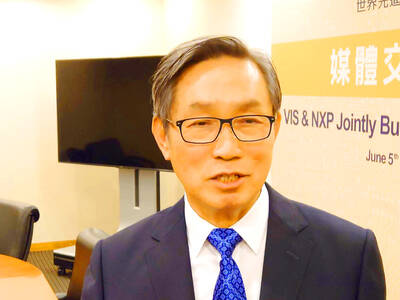The Ministry of Economic Affairs has ordered state-run Taiwan Power Co (Taipower, 台電) to build a new wastewater treatment facility for its coal-fired Taichung Power Plant in two years, Deputy Minister of Economic Affairs Tseng Wen-sheng (曾文生) said.
The plant is the largest single stationary source of air pollution in central Taiwan and has been found to have repeatedly discharged polluted wastewater.
The Taichung City Government last week fined the plant NT$20 million (US$648,130) for releasing polluted industrial wastewater and ordered it to submit a proposal to improve wastewater management within 30 days.
Taipower must submit such a plan to the city by the end of this month, Tseng said on Saturday last week.
In the meantime, the ministry asked Taipower to ensure stable power supply as the Taichung plant is a key supplier of electricity to the nation, especially during the hot summer months, he said.
The plant has suspended operation of its third and fourth generators, and cut the power generation of its first and second generators by 50 percent to meet the city’s wastewater standards and avoid fines.
However, faced with the need to maintain a stable supply of power during the peak summer demand period, Taipower wants to improve its wastewater treatment capacity in the short term to resume operation of the third and fourth generators at 25 percent capacity.
Taipower’s losses ballooned to nearly NT$17.3 billion in the first quarter of the year, from NT$12.5 billion in the same period last year, its financial statement released earlier this month showed.
The company attributed the losses to lower revenue and higher costs of oil, coal and gas, compared with a year earlier.
As summer electricity rates are to go into effect on June 1, Taipower said it expects higher revenue in the second quarter to help pare its losses.
Overall, the company’s accumulated losses totaled NT$121.6 billion as of March 31, the company said.

STEEP DECLINE: Yesterday’s drop was the third-steepest in its history, the steepest being Monday’s drop in the wake of the tariff announcement on Wednesday last week Taiwanese stocks continued their heavy sell-off yesterday, as concerns over US tariffs and unwinding of leveraged bets weighed on the market. The benchmark TAIEX plunged 1,068.19 points, or 5.79 percent, to 17,391.76, notching the biggest drop among Asian peers as it hit a 15-month low. The decline came even after the government on late Tuesday authorized the NT$500 billion (US$15.2 billion) National Stabilization Fund (國安基金) to step in to buoy the market amid investors’ worries over tariffs imposed by US President Donald Trump. Yesterday’s decline was the third-steepest in its history, trailing only the declines of 2,065.87 points on Monday and

TAKING STOCK: A Taiwanese cookware firm in Vietnam urged customers to assess inventory or place orders early so shipments can reach the US while tariffs are paused Taiwanese businesses in Vietnam are exploring alternatives after the White House imposed a 46 percent import duty on Vietnamese goods, following US President Donald Trump’s announcement of “reciprocal” tariffs on the US’ trading partners. Lo Shih-liang (羅世良), chairman of Brico Industry Co (裕茂工業), a Taiwanese company that manufactures cast iron cookware and stove components in Vietnam, said that more than 40 percent of his business was tied to the US market, describing the constant US policy shifts as an emotional roller coaster. “I work during the day and stay up all night watching the news. I’ve been following US news until 3am

Six years ago, LVMH’s billionaire CEO Bernard Arnault and US President Donald Trump cut the blue ribbon on a factory in rural Texas that would make designer handbags for Louis Vuitton, one of the world’s best-known luxury brands. However, since the high-profile opening, the factory has faced a host of problems limiting production, 11 former Louis Vuitton employees said. The site has consistently ranked among the worst-performing for Louis Vuitton globally, “significantly” underperforming other facilities, said three former Louis Vuitton workers and a senior industry source, who cited internal rankings shared with staff. The plant’s problems — which have not

TARIFF CONCERNS: The chipmaker cited global uncertainty from US tariffs and a weakening economic outlook, but said its Singapore expansion remains on track Vanguard International Semiconductor Corp (世界先進), a foundry service provider specializing in producing power management and display driver chips, yesterday withdrew its full-year revenue projection of moderate growth for this year, as escalating US tariff tensions raised uncertainty and concern about a potential economic recession. The Hsinchu-based chipmaker in February said revenues this year would grow mildly from last year based on improving supply chain inventory levels and market demand. At the time, it also anticipated gradual quarter revenue growth. However, the US’ sweeping tariff policy has upended the industry’s supply chains and weakened economic prospects for the world economy, it said. “Now